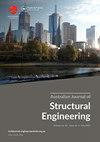基于列车应变时程响应的桁架式铁路桥梁损伤评估工具
IF 1.3
Q4 ENGINEERING, CIVIL
Australian Journal of Structural Engineering
Pub Date : 2021-04-03
DOI:10.1080/13287982.2021.1908710
引用次数: 2
摘要
提出了一种桁架型铁路桥梁的非参数损伤检测方法。该方法使用工作应变时程响应来检测桁架元件的损伤和支持行为的变化。在基线和未知状态桥梁条件下获得的动态应变时程响应用于计算两个连续时间步之间应变值的差值。提出了一种新的损伤敏感特征(DSF),即这些震级平方和的平方根的百分比变化。在基于基线桥梁建立阈值DSF后,通过观察DSF值可以检测和定位桥梁进一步的结构变化或损伤。通过对一座钢桁架铁路桥梁的有限元分析,验证了该方法的有效性。结果表明,所提出的方法在识别、定位和相对评估损伤方面取得了很好的结果,并且即使在不同的运行条件(即不同的列车速度和负载)和测量噪声影响应变数据时也是有用的。因此,所提出的方法有可能有助于制定有效的铁路桥梁维修策略。本文章由计算机程序翻译,如有差异,请以英文原文为准。
A Data-Driven Damage Assessment Tool for Truss-Type Railroad Bridges Using Train Induced Strain Time-History Response
ABSTRACT In this paper, a non-parametric damage detection method for truss-type railroad bridges is presented. The method uses operational strain time-history responses to detect damage in truss elements, and change in support behaviour. Dynamic strain time-history responses obtained under baseline and unknown-state bridge conditions are used to compute the magnitudes of differences in strain values between two successive time-steps. A new damage-sensitive feature (DSF) is proposed as the change in percentage of the square root of the sum of squared values of these magnitudes. After establishing a threshold DSF based on the baseline bridge, further structural change or damage in the bridge could be detected and located by observing the values of the DSFs. The validity of the method is investigated through finite element analysis of a steel-truss railway bridge. It is demonstrated that the proposed method yields promising results for identifying, locating, and relatively assessing the damage, and could be useful even when different operational conditions (i.e. different train speeds and loads) and measurement noise influence the strain data. Therefore, the proposed method has the potential to assist in developing effective maintenance strategies for railway bridges.
求助全文
通过发布文献求助,成功后即可免费获取论文全文。
去求助
来源期刊

Australian Journal of Structural Engineering
ENGINEERING, CIVIL-
CiteScore
2.50
自引率
0.00%
发文量
31
期刊介绍:
The Australian Journal of Structural Engineering (AJSE) is published under the auspices of the Structural College Board of Engineers Australia. It fulfils part of the Board''s mission for Continuing Professional Development. The journal also offers a means for exchange and interaction of scientific and professional issues and technical developments. The journal is open to members and non-members of Engineers Australia. Original papers on research and development (Technical Papers) and professional matters and achievements (Professional Papers) in all areas relevant to the science, art and practice of structural engineering are considered for possible publication. All papers and technical notes are peer-reviewed. The fundamental criterion for acceptance for publication is the intellectual and professional value of the contribution. Occasionally, papers previously published in essentially the same form elsewhere may be considered for publication. In this case acknowledgement to prior publication must be included in a footnote on page one of the manuscript. These papers are peer-reviewed as new submissions. The length of acceptable contributions typically should not exceed 4,000 to 5,000 word equivalents. Longer manuscripts may be considered at the discretion of the Editor. Technical Notes typically should not exceed about 1,000 word equivalents. Discussions on a Paper or Note published in the AJSE are welcomed. Discussions must address significant matters related to the content of a Paper or Technical Note and may include supplementary and critical comments and questions regarding content.
 求助内容:
求助内容: 应助结果提醒方式:
应助结果提醒方式:


